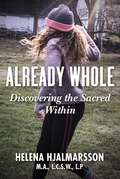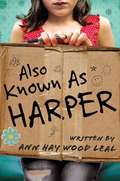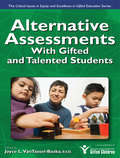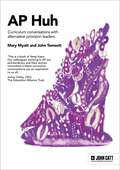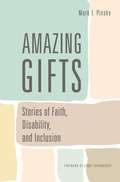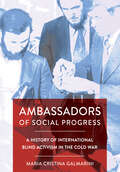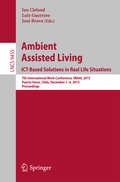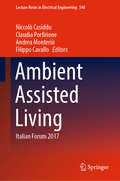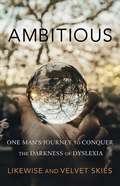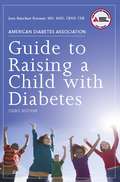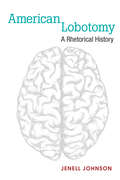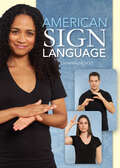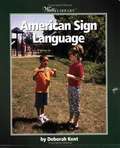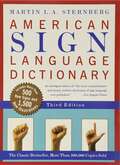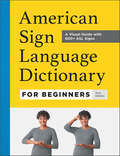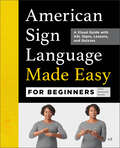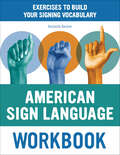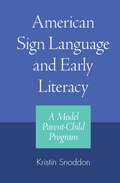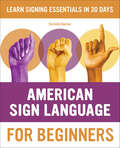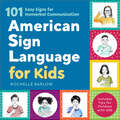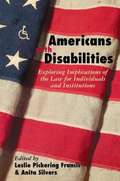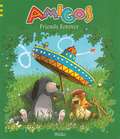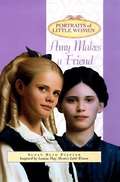- Table View
- List View
Already Whole: Discovering the Sacred Within
by Helena HjalmarssonMany of us have made our lives so noisy, overwhelming, sensory craving and data driven that we have somehow missed the most fundamental part about ourselves and our lives. Learning how to work with every process, every situation, every relationship intuitively; learning to love what is, to let go, to have faith and find stillness; to foster one&’s intuition and become creative in our own lives is something we can all achieve. To illustrate these concepts, Hajlmarsson calls on her decades of experience and work as a psychotherapist. But most significantly, her life as an autism parent, accounted for in her previous books, Finding Lina 2013 and Beyond Autism 2019, which has taught her where to find that elusive freedom and harmony: inside herself. Hjalmarsson believes that the solution to life's chaos, this freedom and harmony—this love—is accessible to all. She writes, "We don&’t earn freedom. We either realize who we are and how we can live free, connected, joyful and expansive lives or we don&’t. We can realize it some of the time and live a little bit connected and a little bit trapped. Or we can learn to realize it most of the time and spend most of our lives fully awake."
Also Known as Harper
by Ann Haywood LealHarper Lee Morgan is an aspiring poet, which isn't surprising, seeing as how she's named after her mama's favorite writer, Harper Lee. And life is giving her a lot to write about just now. Daddy up and walked out, leaving them broke. Then Harper's family gets evicted. With Mama scrambling to find work, Harper has to skip school to care for her little brother, Hemingway. Their lives have been turned upside down, which Harper could just about handle--if it wasn't for the writing contest at school. If only she could get up on that stage and read her poems out loud ...
Alternative Assessment With Gifted and Talented Students
by Van Tassel-BaskaAlternative Assessments for Identifying Gifted and Talented Students provides a concise and thorough introduction to methods for identifying gifted students in the school setting.
Alternative Provision Huh
by John Tomsett Mary MyattFor one reason or another, mainstream education does not suit every young person. Many young people are educated in alternative provision, which is defined by the Department for Education as educational provision 'for pupils who, because of exclusion, illness or other reasons, would not otherwise receive suitable education'. As of 2023, over 25,000 young people are enrolled in alternative provision, and those numbers continue to rise.It is essential, then, that the curriculum on offer in alternative provision is exemplary, as these young people - already facing extraordinary challenges - need the very best if they are going to progress successfully into adulthood.Huh is the Egyptian god of endlessness, creativity, fertility and regeneration. He is the deity Mary Myatt and John Tomsett have adopted as their god of the curriculum. Their Huh series of books focuses on how practitioners design the curriculum for the young people in their schools.The Huh project is founded on conversations with colleagues doing great work across the education sector. In AP Huh, Mary Myatt and John Tomsett discuss curriculum provision for pupils attending alternative provision with some of the leading experts in the field. Mary and John interviewed pupils, parents, teachers, headteachers, CEOs, educational consultants and lecturers. They then edited the transcriptions of those interviews to provide an ambitious, thoughtful, nuanced and challenging vision of what the best possible provision looks like for children who find that mainstream schooling is not for them.The challenging conversations that comprise AP Huh paint a positive picture that is hugely hopeful for the future of the curriculum in our alternative provision settings.
Amazing Gifts: Stories Of Faith, Disability, And Inclusion
by Mark I. PinskyStories of Faith, Disability, and Inclusion
Amazing Grace: Inspirational Poetry
by Donovan MitchellDonovan Mitchell has been serving God faithfully for the last 28 years. His confinement to a wheelchair, has not deterred neither has it dampened his spirit, and love for the church and for his Lord. The poetic gift that God has impregnated him with has been a blessing to the local church in particular and to the community in general. At Mount Carmel Church Donovan Mitchell is accepted and accommodated as a human being of equal dignity and standing (status). I believe that the dissemination of the message of the love of God, inherent and tangible in the poems will administer the mercies of heaven to the reader of this inspirational poetry born from heaven. The motivational ambiance of this body of poetic works, is the fulfillment of the prophecy that God gave to Donovan on the 4th January 2003 when the spirit said to him, "write down your feelings on a piece of paper..." Amazing Grace Inspirational poetry is the result of his obedience to the voice of the Spirit on that faithful day.
Amazing Gracie: A Dog's Tale
by Dan Dye Mark Beckloff Richard SimonIt was love at first sight. Amid the frenzied barking and prancing of a house full of Great Danes, one pup was shivering in the corner. Gracie. But when Dan Dye reached her, she struggled to her feet like a clumsy foal, raised her forehead to his, and announced, as clearly as if she had actually spoken the words, You know I'm the one. Now get me outta here! By turns funny, moving, tender, and inspiring, Gracie's tale is a treat for every dog lover. There is Gracie's first morning, racing around Dan in the snowy yard. Gracie's determination to prove to her sisters, Dottie the Dalmatian and Sarah the Black Lab, that she's "one of the girls." Gracie's defiant romance with a pint-size charmer named Byron, a Boston Terrier from the wrong side of the fence. Then born of necessity, the eureka moment: When Gracie's delicate constitution starts turning into anorexia, Dan teaches himself how to cook, and in three days is baking her the cookies that will spur her appetite, launch Three Dog Bakery, and transform their lives forever. Courage. Compassion. Kindness. Soul. Tenacity. And joy--above all, joy. These qualities Gracie possessed in abundance, and shared with everyone, human or canine, who had the good fortune to cross her path.
Ambassadors of Social Progress: A History of International Blind Activism in the Cold War (NIU Series in Slavic, East European, and Eurasian Studies)
by Maria Cristina GalmariniAmbassadors of Social Progress examines the ways in which blind activists from the Soviet Union and Eastern Europe entered the postwar international disability movement and shaped its content and its course. Maria Cristina Galmarini shows that the international work of socialist blind activists was defined by the larger politics of the Cold War and, in many respects, represented a field of competition with the West in which the East could shine. Yet, her study also reveals that socialist blind politics went beyond propaganda. When socialist activists joined the international blind movement, they initiated an exchange of experiences that profoundly impacted everyone involved. Not only did the international blind movement turn global disability welfare from philanthropy to self-advocacy, but it also gave East European and Soviet activists a new set of ideas and technologies to improve their own national movements. By analyzing the intersection of disability and politics, Ambassadors of Social Progress enables a deeper, bottom-up understanding of cultural relations during the Cold War. Galmarini significantly contributes to the little-studied history of disability in socialist Europe, and ultimately shows that disability activism did not start as an import from the West in the post-1989 period, but rather had a long and meaningful tradition that was rooted in the socialist system of welfare and needed to be reinvented when this system fell apart.
Ambient Assisted Living. ICT-based Solutions in Real Life Situations: 7th International Work-Conference, IWAAL 2015, Puerto Varas, Chile, December 1-4, 2015, Proceedings (Lecture Notes in Computer Science #9455)
by José Bravo Ian Cleland Luis GuerreroThis book constitutes the refereed proceedings of the 7th International Work-Conference on Ambient Assisted Living, IWAAL 2015, held in Puerto Varas, Chile, in December 2015. The 20 full papers presented with 7 short papers were carefully reviewed and selected from 31 submissions. The focus of the papers is on following topics: ambient assisted living for tele-care and tele-rehabilitation; ambient assisted living environments; behaviour analysis and activity recognition; sensing for health and wellbeing; human interaction and perspectives in ambient assisted living solutions.
Ambient Assisted Living: Italian Forum 2017 (Lecture Notes in Electrical Engineering #540)
by Andrea Monteriù Filippo Cavallo Niccolò Casiddu Claudia PorfirioneThis book documents the state of the art in the field of ambient assisted living (AAL), highlighting the impressive potential of novel methodologies and technologies to enhance well-being and promote active ageing. It covers a broad range of topics, with sections on technological sensors and platforms, social robotics for assistance, assistance and care applications, health and medical support methodologies and technologies, as well as the analysis, modelling and design of AAL services. <P><P> The book comprises a selection of the best papers presented at the 8th Italian Forum on Ambient Assisted Living (ForitAAL 2017), which was held in Genoa, Italy, in June 2017 and brought together researchers, technology teams and professional associations, as well as representatives of the Italian regions and advisors to the Italian Ministry of Education, University and Research, with the goal of developing a consensus on how to improve provisions for the elderly and impaired. The respective contributions offer valuable insights into how the latest advances can help address the needs of the elderly and those with chronic health conditions. They also underscore the need for AAL to continue moving toward multidisciplinary integration, so as to embrace the various disciplines that place the user of services at the centre of the design process.
Ambitious: One Man's Journey to Conquer the Darkness of Dyslexia
by LikewiseAmbitious is an autobiography that chronicles the life of a remarkable man who overcame his learning disabilities and other major difficulties to become a highly respected and successful adult.This book is an autobiography that chronicles the life of a remarkable man who overcame his learning disabilities and other major difficulties to become a highly respected and successful adult. For many, only one of these issues he faced would have been enough of a reason to give up. Not so with Likewise who always found creative solutions in order to grow and succeed. It was his desire to share these experiences with others in hopes that he could help them realize their potential no matter what challenges they face.
American Diabetes Association Guide to Raising a Child with Diabetes
by Jean Betschart RoemerThe American Diabetes Association Guide to Raising a Child with Diabetes, 3rd edition features the latest advances in diabetes care to help your child have a healthy active childhood. Full of problem-solving examples and easy-to-use tables, you will learn how:To adjust insulin to allow for the foods kids love to eatTo help the child with type 2 diabetesTo plan meals that are nutritious and balancedTo play sports and games safelyTo handle sick daysYour child can maintain a busy schedule and still feel healthy and strongTo negotiate the twists and turns of being "different"To accept the physical and emotional challenges that life has to offerAnd much more
American Lobotomy: A Rhetorical History
by Jenell JohnsonAmerican Lobotomy studies a wide variety of representations of lobotomy to offer a rhetorical history of one of the most infamous procedures in the history of medicine. The development of lobotomy in 1935 was heralded as a "miracle cure" that would empty the nation's perennially blighted asylums. However, only twenty years later, lobotomists initially praised for their "therapeutic courage" were condemned for their barbarity, an image that has only soured in subsequent decades. Johnson employs previously abandoned texts like science fiction, horror film, political polemics, and conspiracy theory to show how lobotomy's entanglement with social and political narratives contributed to a powerful image of the operation that persists to this day. The book provocatively challenges the history of medicine, arguing that rhetorical history is crucial to understanding medical history. It offers a case study of how medicine accumulates meaning as it circulates in public culture and argues for the need to understand biomedicine as a culturally situated practice.
American Sign Language
by Catherine NicholsIt's the third most used language in the United States-and yet it's "spoken" without even opening your mouth! It's estimated that as many as two million Americans speak American Sign Language, a method of communication that's both fun and useful, even if you or your friends and family are not hearing impaired.American Sign Language uses simple-to-follow photographs to teach you the alphabet, numbers, and simple words and phrases. Divided into categories such as Animals and People and Pronouns, the book and accompanying flashcards show you how to use your hands to communicate. Once you've learned the alphabet, you'll build on that knowledge to learn the words for "friend" and "family." And when you how the words for "chicken" and "cat" evoke a chicken opening and closing its beak and a cat stroking its whiskers, you'll truly understand how intuitive and enjoyable learning American Sign Language can be.Learning a new language is always a rewarding endeavor-and with American Sign Language, it's easier than ever!
American Sign Language
by Deborah KentThis book gives young readers a brief overview of American Sign Language (ASL). The book focuses on the history of ASL and the controversies which have surrounded it since its inception.
American Sign Language Dictionary
by Martin L. SternbergDeaf since the age of seven, Martin L. A. Sternberg, Ed.D., spent most of his career working with deaf people. Inspired by his sign language teacher at Gallaudet University in Washington, DC, he devised this vital reference to help anyone learn to speak with their hands. <p><p>A must for parents, instructors, and students, American Sign Language Dictionary includes everything you need to know to communicate clearly using ASL. This illustrated abridgment of the most authoritative reference book on sign language features more than 5,000 signs and 8,000 illustrations, as well as clear, detailed instructions to help you master each sign.
American Sign Language Dictionary for Beginners: A Visual Guide with 800+ ASL Signs
by Tara AdamsA user-friendly dictionary with 800+ ASL signs Whatever your reason for learning the richly expressive language of American Sign Language (ASL), this book will guide you through the initial stages of your signing journey. It's filled with everything you need to master more than 800 essential vocabulary words, including detailed directions that make it simple to develop your ASL skills.What sets this dictionary apart from other sign language books for beginners:No experience required—Find comprehensive, clearly written guidance that makes sense of American Sign Language for beginners, with helpful explanations of more difficult concepts, plus plenty of tips for success.Instructional photographs—See ASL in action with full-color photographs that illustrate how to sign each vocabulary word.Easy-to-find signs—Study each sign in alphabetical order or search by category with a handy index that organizes signs by activities, animals, emotions, places, events, and more.Build up your ASL vocabulary with the American Sign Language Dictionary for Beginners.
American Sign Language Made Easy for Beginners: A Visual Guide with ASL Signs, Lessons, and Quizzes
by Travis Belmontes-MerrellLearn American Sign Language the easy way! Become a lifelong learner of American Sign Language (ASL) with this guide for true beginners. It breaks down ASL fundamentals and gives you step-by-step instructions for signing more than 400 vocabulary words, organized by practical topics like greetings, hobbies, times, places, and more.The building blocks of ASL—Lay the foundation for ASL learning as you explore the five parameters of signing: handshape, location, movement, palm orientation, and non-manual markers.Clear guidance for novices—Learn how to sign each vocabulary word with the help of detailed written directions and large, full-color photos, so you know you're doing it right even if it's your first sign ever.Lessons and quizzes—Put your new skills to the test with themed lessons designed for real-world conversations, and brief quizzes at the end of each section.Make learning ASL fun and easy with this top choice in American Sign Language books for beginners.
American Sign Language Workbook: Exercises to Build Your Signing Vocabulary
by Rochelle BarlowThe simple way to start learning American Sign LanguageThis foundational workbook makes it easy to get started with American Sign Language. Focusing on practical vocabulary and basic grammar, this workbook is ideal for anyone trying to understand and speak ASL right away. Across 30+ lessons, you'll be introduced to the essentials, including everyday vocabulary, introductory phrases, and conversational basics.Everyday communication—Lessons are centered around real-world situations, including greetings, emotions, family, work, travel, and health.Easy-to-understand lessons—High-quality photos support the straightforward sign descriptions and ensure accurate instruction.Practice makes perfect—Test your knowledge with a variety of exercises, including matching, fill-in-the-blanks, and more.Lay the foundation for strong signing skills with the simple exercises in this sign language workbook.
American Sign Language and Early Literacy: A Model Parent-Child Program
by Kristin SnoddonThe usual definition of the term "literacy" generally corresponds with mastering the reading and writing of a spoken language. This narrow scope often engenders unsubstantiated claims that print literacy alone leads to, among other so-called higher-order thinking skills, logical and rational thinking and the abstract use of language. Thus, the importance of literacy for deaf children in American Sign Language (ASL) is marginalized, asserts author Kristin Snoddon in her new book American Sign Language and Early Literacy: A Model Parent-Child Program. As a contrast, Snoddon describes conducting an ethnographic, action study of the ASL Parent-Child Mother Goose program, provided by a Deaf service agency in Ontario, Canada to teach ASL literacy to deaf children. According to current scholarship, literacy is achieved through primary discourse shared with parents and other intimates, which establishes a child's initial sense of identity, culture, and vernacular language. Secondary discourse derives from outside agents and interaction, such as expanding an individual's literacy to other languages. Snoddon writes that the focus of the ASL Parent-Child Mother Goose program is on teaching ASL through rhymes and stories and some facets of the culture of Deaf ASL users. This focus enabled hearing parents to impart first-language acquisition and socialization to their deaf children in a more natural primary discourse as if the parents were Deaf themselves. At the same time, hearing parents experience secondary discourses through their exposure to ASL and Deaf culture. Snoddon also comments on current infant hearing screening and early intervention and the gaps in these services. She discusses gatekeeper individuals and institutions that restrict access to ASL for young Deaf children and their families. Finally, she reports on public resources for supporting ASL literacy and the implications of her findings regarding the benefits of early ASL literacy programming for Deaf children and their families.
American Sign Language for Beginners: Learn Signing Essentials in 30 Days
by Rochelle BarlowA 30-day beginner's guide for learning American Sign LanguageThere's an easy way to leap right in to learning American Sign Language (ASL). American Sign Language for Beginners delivers 30 days of lessons that will help you sign with those in your home, community, and classroom.From letters and numbers to essential vocabulary and grammar basics, this beginner's guide provides the essentials needed to develop a solid foundation for American Sign Language in the real world. Each daily lesson takes less than 30 minutes to complete and focuses on a single set of vocabulary or ASL grammar. Throughout the course, you'll find key phrases, helpful memory tips, signing practice activities, and insight into deaf culture. Start your ASL masterclass today.American Sign Language for Beginners includes:30 Days of easy ASL—Start off right with an accelerated plan designed to help you begin signing in just one month.Easy-to-understand instructions—Lessons concentrate on a single idea or subject and include photographs to demonstrate signs.Everyday phrases—Daily instruction highlights vocabulary you're most likely to need as you explore ASL in your daily life.Jump-start your learning experience with American Sign Language for Beginners!
American Sign Language for Kids: 101 Easy Signs for Nonverbal Communication
by Rochelle BarlowThe easy way for kids ages 3 to 6 (and parents) to learn American Sign LanguageThere has never been a better way to start learning American Sign Language. Ideal for parents of nonverbal children or children with communication impairments in the preschool or kindergarten age range, American Sign Language for Kids offers a simple way to introduce both of you to ASL.Build your vocabularies with 101 signs perfect for everyday use, all featuring detailed illustrations, memory tips, and hands-on activities. American Sign Language for Kids helps you focus on the types of words you need most with chapters conveniently divided by category. Get chatty with activities that guide you through conversations. You'll be signing together in no time!American Sign Language for Kids includes:101 Helpful signs—From family and feelings to meals and playtime, work with your child to master subjects that will help the two of you connect.Fun ways to practice—Discover enjoyable activities at the end of each section that make it exciting and engaging to learn signs and start conversing!Practical guides—Get useful advice for introducing signs to a child with autism, helpful primers on deaf culture, and more.Discover an effective and meaningful way to deepen communication with your child—American Sign Language for Kids shows you the way.
Americans with Disabilities: Exploring Implications of the Law for Individuals and Institutions
by Anita Silvers Leslie Pickering FrancisFew laws have sparked as much debate as the Americans with Disabilities Act (ADA), passed by Congress in 1990. With thought-provoking analysis by noted experts in a variety of fields, this book provides a keen understanding of the consequences of the law--for both those who oppose burdensome costs of the law and those who feel it must do more to protect citizens with disabilities from intolerance and social limitation.
Amigos: Friends Forever
by WalkoThe world can present many obstacles-for people with a handicap, simply getting from place to place can be a major challenge. A dog named Pedro wants to explore the world but his lack of sight makes it too dangerous for him to dodge the whizzing cars on a busy street. He meets Rosalie the cat, who is also on a journey but her damaged leg prevents her from crossing the street quickly and unharmed. The pair realizes that they can use each other's strengths to work together and accomplish the task.A charming story about friendship and special needs, incorporating Spanish words with humor and wit, Amigos shows that anything is possible with a caring friend by your side. Even with handicaps, Pedro and Rosalie are able to overcome the hardest challenges by sticking together. This book will teach children the value of friendship, acceptance, and perseverance.
Amy Makes a Friend (Portraits of Little Women)
by Susan Beth PfefferAmy March wants to be a great artist. She's got the talent; now all she needs is a way to afford art lessons. Her solution: befriend her rich and snobby classmate, Jenny Snow, who'll then invite Amy to sit in on her private art instructions. But Jenny can't be bothered with Amy's friendly overtures -- until Diana Hughes, a new and extremely wealthy girl, chooses Amy as her friend. Now, Amy thinks Jenny will like her too. But the price of art lessons may be higher than Amy ever imagined....
